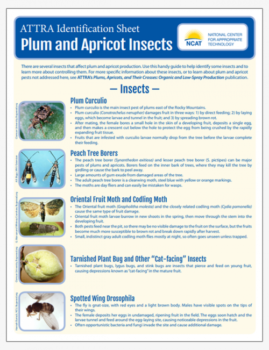ATTRA Identification Sheet: Plum and Apricot Insects
By Guy K. Ames, NCAT Agriculture Specialist
There are several key diseases that affect plum production. Use this handy guide to help identify some diseases and to learn more about causes and solutions.
Insects
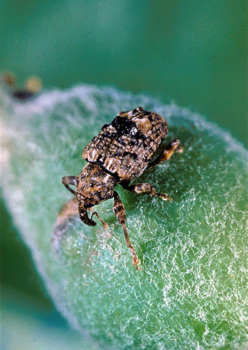
Plum curculio adult. Photo: Clemson University, Bugwood.org
Plum Curculio
Plum curculio (Conotrachelus nenuphar) is the main insect pest of plums east of the Rocky Mountains. It damages fruit in three ways: 1) by direct feeding; 2) by laying eggs which become larvae and tunnel in the fruit; and 3) by spreading brown rot.
After mating, the female bores a small hole in the skin of a developing fruit, deposits a single egg, and then makes a crescent cut below the hole to protect the egg from being crushed by the rapidly expanding fruit tissue.
Fruits that are infested with curculio larvae normally drop from the tree before the larvae complete their feeding.
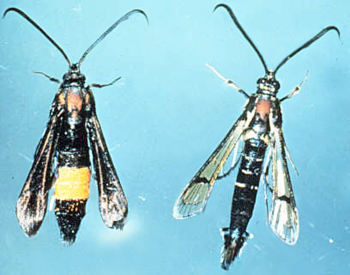
Peachtree borer (female L.). Photo: A.R. Biggs, West Virginia University Extension
Peach Tree Borers
The peach tree borer (Synanthedon exitiosa) and lesser peach tree borer (S. pictipes) can be major pests of plums and apricots. Borers feed on the inner bark of trees, where they may kill the tree by girdling or cause the bark to peel away.
Large amounts of gum exude from damaged areas of the tree. The adult peach tree borer is a clearwing moth, steel blue with yellow or orange markings.
The moths are day fliers and can easily be mistaken for wasps.

Oriental fruit moth. Photo: G. Morvan, Bugwood.org
Oriental Fruit Moth and Codling Moth
The Oriental fruit moth (Grapholitha molesta) and the closely related codling moth (Cydia pomonella) cause the same type of fruit damage.
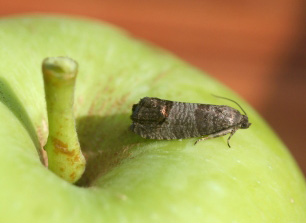
Adult coddling moth. Photo: G. Morvan and Whitney Cranshaw, Bugwood.org
Oriental fruit moth larvae burrow in new shoots in the spring, then move through the stem into the developing fruit.
Both pests feed near the pit, so there may be no visible damage to the fruit on the surface, but the fruits become much more susceptible to brown rot and break down rapidly after harvest.
Small, indistinct gray adult codling moth flies mostly at night, so often goes unseen unless trapped.
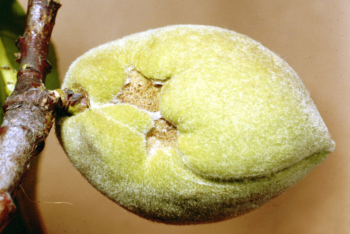
Tarnished plant bug. Photo: Clemson University, Bugwood.org
Tarnished Plant Bug and Other “Cat-facing” Insects
Tarnished plant bugs, lygus bugs, and stink bugs are insects that pierce and feed on young fruit, causing depressions known as “cat-facing” in the mature fruit.
Spotted Wing Drosophila
The fly is gnat-size, with red eyes and a light brown body. Males have visible spots on the tips of their wings.
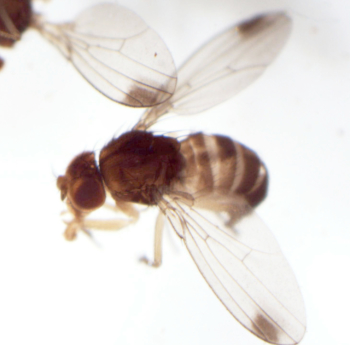
Spotted wing drosophila adult. Photo: Hannah Burrack, NCU, Bugwood.org
The female deposits her eggs in undamaged, ripening fruit in the field. The eggs soon hatch and the larvae tunnel and feed around the egg-laying site, causing noticeable depressions in the fruit.
Often opportunistic bacteria and fungi invade the site and cause additional damage.
Key Low-Spray and Organic Solutions
Plum Curculio
Disking or otherwise cultivating orchard soil during the pupal period is a mechanical control method for plum curculio, but whole-orchard cultivation can lead to severe erosion and loss of soil organic matter. Growers with any orchard history of plum curculio damage often tend to forego early monitoring and simply begin sprays at petal fall. Surround WP Crop Protectant, derived from processed kaolin clay, is an OMRI-approved organic pest-control product shown to be effective for control of plum curculio. PyGanic is an OMRI-approved, pyrethrum-based, quick-knockdown, short-residual, broad-spectrum insecticide that seems to be the pesticide of choice for organic plum curculio control. Note that it will also kill beneficials. It is highly toxic to bees and should never be sprayed during bloom.
Peach Tree Borers
Prevent damage to the tree trunk in order to minimize borer attack. Pheromones for both borer monitoring and borer mating disruption are effective and available. Interior white latex paint, painted or sprayed on the base of trunks, provides a physical barrier but is not a substance that is allowed in organic production. Growers with small plots can use the exudate to locate a larva, and then kill it by using a knife or flexible wire to probe it out of the trunk. The bacterium Bacillus thuringiensis (Bt) can be used to control the larvae before they have entered the trunk. The commercially available insect-parasitic nematode Steinernema carpocapsae has also been used successfully to manage peachtree borers when applied as a lower-trunk drench in warm spring or fall weather.
Oriental Fruit Moth and Codling Moth
Trees that are allowed to grow dense, succulent foliage are especially attractive to the moths.
Pheromone-based mating disruption systems for Oriental fruit moth and codling moth are proven, effective, and easy to use. Degree-day models or charts can help growers in timing pesticide application or placement of mating disruption lures to coincide with the emergence of the pest. Good orchard sanitation—removing leaf litter and dropped or culled fruit where larvae overwinter—will further reduce attacks. Parasitic braconid wasps can be used as part of an IPM strategy against the Oriental fruit moth. Some growers supplement a parasitic insect program with a single spray of an appropriate insecticide shortly before harvest.
Tarnished Plant Bug and Other “Cat-facing” Insects
The best cultural control for these insects is orchard sanitation and regular, close mowing of the orchard floor to deny them habitat. An alternative strategy is to use habitat plantings that attract these bugs as well as their predators. Predators of these pests include bigeyed bugs, damsel bugs, assassin bugs, and collops beetle, as well as the egg predator minute pirate bug, and the egg parasite Anaphesioles. In addition to these potential controls, botanicals such as PyGanic and neem appear effective against tarnished plant bug. Surround is also effective but will leave a residue on the fruit if used mid-season, when these insects are a problem.
Spotted Wing Drosophila
The least-toxic, effective pesticide appears to be GF-120 NF Naturalyte Fruit Fly Bait, which attracts and kills the SWD. The active ingredient in GF-120 is spinosad, a biological insecticide which is OMRI approved. Oregon State University has developed a simple and inexpensive trap for monitoring.
ATTRA Identification Sheet: Plum and Apricot Insects
By Guy K. Ames, NCAT Agriculture Specialist
Published November 2014
©NCAT
IP487, slot 499
This publication is produced by the National Center for Appropriate Technology through the ATTRA Sustainable Agriculture program, under a cooperative agreement with USDA Rural Development. ATTRA.NCAT.ORG.

